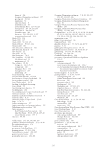7 – Connecting the champions of the Lake Eyre Basin rivers 89 popularity of the poster has seen it updated and reprinted twice since its first release. Many other communication initiatives have since served to increase community awareness of the unique values of the Basin. The Lake Eyre Basin People and Passion project includes evocative short films from the heart of Australia (http://www.dcsolutions.org.au/showcase/#&panel1-1), made possible by a collaboration between the Ministerial Forum’s Community Advisory Committee, Desert Channels Queensland and Territory Natural Resource Management. The films feature over 20 distinctive characters of the Basin – pastoralists, botanists, Indigenous rangers, ecologists, Traditional Owners and tourism operators. Their inspiring stories tell of personal passion and drive to care for the Basin’s rivers, wildlife and floodplains. As well, the Australian Broadcasting Corporation featured the floods of 2010–11 in a magnificent television documentary, followed by a book (Lockyer 2012) showcasing the Basin’s people and communities, spectacular landscapes, desert wildlife and the often dramatic and unpredictable natural cycles of life in the Basin. A poster titled Lake Eyre Basin Aboriginal Way, featuring images, maps and quotations about the enduring connection of Aboriginal people to the Basin and its rivers, was published in 2017. The culmination of extensive and respectful engagement of Aboriginal groups from across the Basin, this was arguably a ground-breaking communication project with few parallels in Australian catchment management. Championing future sustainability of the rivers Scientific understanding about the ecological values of the river and the Basin has continued to increase, as has awareness of the impacts of water resource developments on communities and ecosystems in other inland river basins. Rigorous science over three decades has produced a deep understanding of the boom and bust cycles of the rivers, while the Lake Eyre Basin Rivers Assessment tracks the condition of the rivers. Regional bodies (Fig. 7.2a) have focused on land management programs, in particular the control of invasive species, as well as community education and engagement. There will be increasing pressure on governments and communities to develop the rivers of the Lake Eyre Basin (see Chapter 22), even if this is through indirect impacts such as mining exploration and development (see Chapter 19). The history of Lake Eyre Basin partnerships has taught us that government policies can easily change in favour of development, with individuals willing to promote such approaches (see Chapter 17). Policy settings and legislation in Queensland relating to water resource management are crucial, as this is where most of the river flows in the Lake Eyre Basin originate (see Chapter 20). Until clear legislative and policy frameworks are in place to protect the rivers, river flows will remain vulnerable to development. At a local and basin scale, there is increasing impetus for focused monitoring, targeting objectives related to management. It is no longer sufficient to simply understand environmental values – our growing scientific knowledge must influence management. To this end, governments of the Lake Eyre Basin endorsed a new Strategic Adaptive Management framework for the rivers in 2010 (Table 7.1). This framework involves a rigorous process where values inform a vision which can then drive development of a hierarchy of objectives linked to monitoring and science (Fig. 7.7 Kingsford et al. 2011
Downloaded from CSIRO with access from at 216.73.216.88 on Nov 13, 2025, 5:04 AM. (c) CSIRO Publishing

















































































































































































































































































